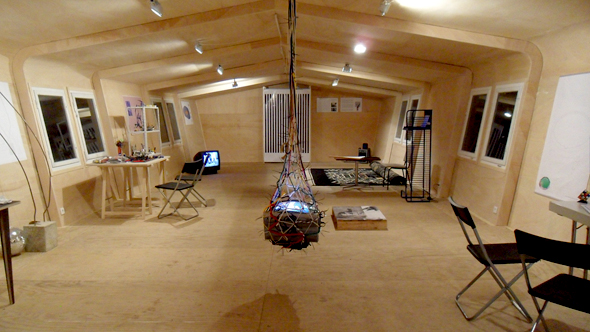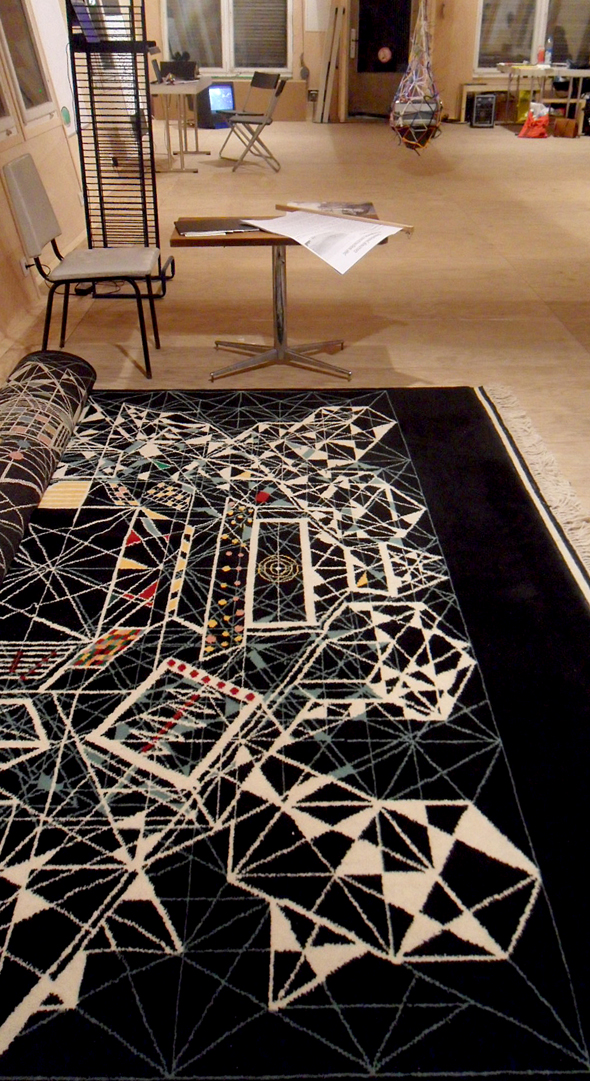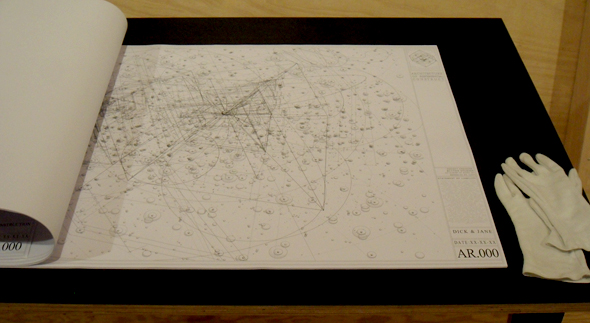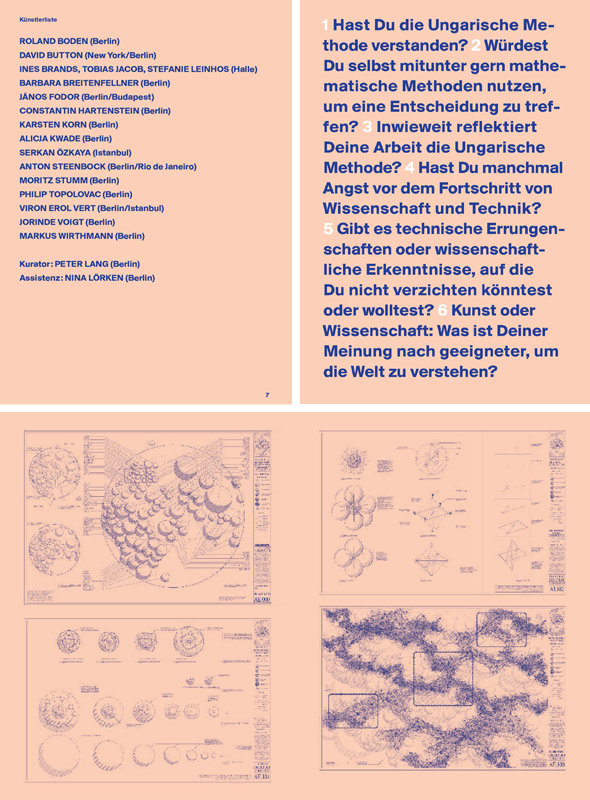by Elizabeth Feder // Mar. 25, 2012
Our contemporary western world is heavily mechanized, mapped, and planned. Besides the clearly calculated constraints of train schedules, tax identification numbers, and building codes, the minutia of our everyday lives are built on a hidden foundation of optimized orchestration. “Die Ungarische Methode,” an exhibition recently on view at REH Kunst, explored this relationship between the mathematical precision of a quietly prevalent world-organizing algorithm, and the imperfect, unpredictable and chaotic condition of its ever-dependent utilizers.
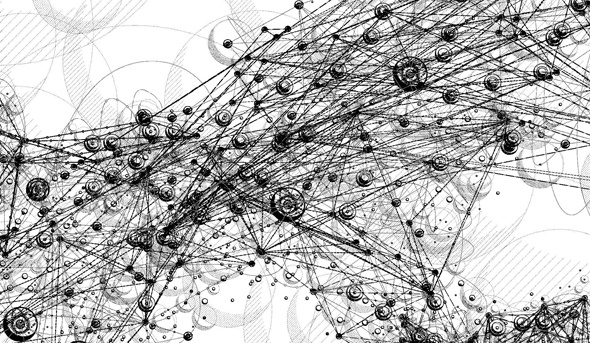
David Button: Paradigm, 2011, detail, 2D computer drawings, architectural drawing set of 32 inkjet prints, 59,4×84,1 cm // Image courtesy of David Button Studios, 2012
The Hungarian method, for which the group show was named, is a mathematical algorithm largely based on the works of two Hungarian mathematicians from the early 20th century. In many ways, the algorithm is a construct for determining certain conditions between separate entities, and the specified qualities assigned to them. It is greatly important to the functioning of our digital universe, for it is the perfect system for predicating and substantiating relationships. From the programming languages of Java and Python, to the algorithms that web-dating services utilize in order to bring would-be lovers together, the Hungarian method is deeply woven into our daily routines.
“Die Ungarische Methode” brought together fifteen artists to REH (Raumerweiterungshalle, or space expansion hall) in order to stimulate a response to this multifaceted question of interconnectivity, relational theory, and mathematical choreography. Each project offered a starkly different view of the over-aching theme, which created a lively and curious diversity in the hall. Many pieces took on the scientific and mathematically graphical language of the prompt, others tapped into deeply personal techniques, such as rug-making or constructing objects through children’s toys.
Berlin Art Link sat down with “Die Ungarische Methode’s” curator, Peter Lang, and one of the participating artists, David Button, before the end of the show to get both a greater understanding of the project as a whole, as well as one artist’s personal exploration.
ELIZABETH FEDER: Peter, what is the Hungarian method for you?
PETER LANG: It was an idea to begin thinking with a couple of artists about this mathematic algorithm. Is it possible to use this on a conceptual level, not as a scientist or a mathematician? How do we understand this way of thinking? As this construct is so connected to our everyday lives, we have to understand this to make decisions for our future. But our understanding of it is so fragile, for many it doesn’t exist at all. Therein exists a conflict, of course. I think it’s a conflict for society today. So we’ve made a small laboratory at the REH to play a little bit with this idea and the questions that it inspires.
All the artists explored their own ideas through process-oriented works that confronted this question of understanding. These work that you see aren’t really art pieces then, but their own exercises of the Hungarian method. So as you can see, there’s a wide range of experiments. We have a Turkish carpet that plays with a lot of very old ideas of ornamentation and pattern-making, which are mathematical in nature and have a lot to do with religion and culture. Then you have the piece of David Button, which is a mathematical construction that has been developing for years now. It comes from a deep-seeded interest that he’s been investigating for a long time. What is the universe? What are we doing in the universe? What are we composed of, but in a more abstract way? Then we can go further, we can ask, therefore, what is the universe composed of? There is a lot of play in the room, a lot of freedom to explore was exercised here.
Why was the Hungarian method such a strong guiding principle, as opposed to any other theorem or methodology?
PL: It’s more an example for all mathematical methods. It started as an idea of a friend of mine. We were brainstorming ideas for a show and we were thinking about Eastern Europe, specifically considering different ways of thinking and making in different Eastern European countries. We became interested in the Hungarian method in particular because it allowed for this simultaneity of thought: a balance between strict mathematical rigidity and infinite possibility. It’s analogous to what we are and what rules we follow to make decisions for the future. The Hungarian Method was first invented in the ’20s by two Hungarian mathematicians, giving it the name. Now it is used quite often to help our everyday construct function. For instance, many internet platforms that call for matching information to a specific focus essentially use the Hungarian method to sort and select data. Like a dating website that asks for you to put in several specific articles of information and is able to generate a series of “matches:” that’s the Hungarian method.
What kind of artists did this project inspire to participate?
PL: Many different practitioners have gotten involved. Artists who work with different media and are from different age-groups and backgrounds offer very different views and ideas related to this overarching theme. We have sculpture, drawing, video, installation, multi-media projects all having a conversation in this one space.
Do you see this process as being a premise for more shows in the future?
PL: Perhaps. Besides the show, we’ve published a small book about the project idea and all of the artists’ submissions. We’ve also done interviews with all the artists about their understanding of the theme and their way of thinking through their works. Additionally, we did a version of the show last year in a small museum. We will see how we can do it in another way in another place.
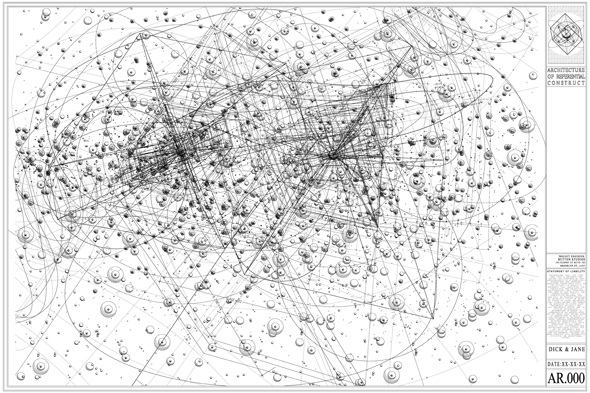
David Button: Paradigm, 2011, 2D computer drawings, architectural drawing set of 32 inkjet prints, 59,4×84,1cm // Image courtesy of David Button Studios, 2012
David Button, how did you interpret the Hungarian method? Peter mentioned that you have been working on this project for years. How did you first get involved with this show?
DAVID BUTTON: Well, it’s kind of a funny coincidence because Peter was already putting the show together when I first met him. He came to my studio, saw my work, and it fit right into his whole modus operandi. The piece that I’ve created is an architectural construction drawing set on “consciousness.” It’s using the architect’s method of describing what to create, that is, what is about to become “real.” I saw it as a good format for this discussion: considering what are the elements that make up what we perceive as real. In the art world, so much of what you create is a kind of fiction, whereas the documents of the architect are intended to guide towards another manifestation, one that is “real.” In creating this blueprint for what I understand as reality, or more specifically, consciousness, my project fell right in line with the idea of the Hungarian method: trying to optimize the elements of what is at play to achieve a very specific objective.
My piece is rhetorical, even ironic, in its approach to the theme because clearly there is no one way to define reality: at the same time, there are things that we cannot deny. I’m playing around with trying to construct a solid definition of what constitutes a relationship while also trying to visualize different relationships that have not yet been conceived of in any other way.
Are you exploring any relationships in particular? In the project descriptions several drawings, there are some curious titles, such as,” The Interactions between Dick and Jane.”
DB: Well let me start to answer that with breaking down how the drawing set is structured. There are three parts: The Construction of the Individual, The Construction of the Environment, and The Referential Construction (between the Individual and the Environment). One element of the set is playing around with, rather referencing the language from, an old English children’s book series, “Dick and Jane.” These books were primarily designed to help children learn how to read and understand certain social and environmental parameters in the western, English-speaking, world: “See Dick run,” “See Jane jump,” and so on. I used these two characters to explore the idea of their first encounter at a bar. So when you go the drawing that explores what happens when they have this interaction, you see their social spheres, or as I’ve represented them, their particle-systems of their consciousness. When they first meet, the energy is generated along the periphery of their social spheres. And when we move on in the drawing set, as these two characters get closer, their social spheres become more intertwined, dynamic and in some cases, unified.
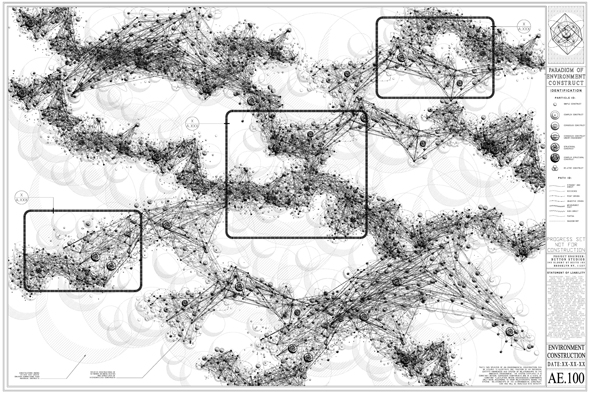
David Button: Paradigm, 2011, 2D computer drawings, architectural drawing set of 32 inkjet prints, 59,4×84,1cm // Image courtesy of David Button Studios, 2012
The drawings are composed of a wild array of spheres, vectors, planes and particles. What do each of these notations signify?
DB: What I’ve designed is an envelope of a larger idea. I’m not aiming to have these marks stand for anything specific, per se. These marks are transferring ideas into symbols, the most basic symbol being the sphere, here part of the particle-system. In the first couple of pages, I identify how the spheres are to be read throughout the set, and how they are to be read in relation to one another. For example, when you have an idea, it can be a very small sphere or a very large sphere, which can then also bind to and contain other ideas. There may be no hierarchy between or order to them, as in this illustration here. However in other larger ideas, for example an education institution, there is a very clear hierarchy and structure: there is a formalized construction. For example, when looking at the economic construct of supply and demand, it’s a very simple and large economic institution, whereas a more complicated idea would be that of bonds or investments. But this drawing set is just getting into the envelope of how this system works.
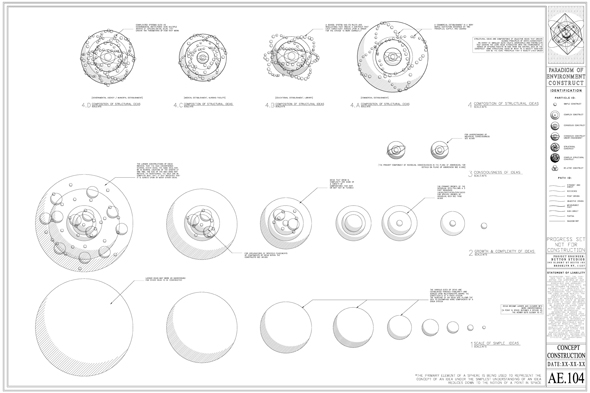
David Button: Paradigm, 2011, 2D computer drawings, architectural drawing set of 32 inkjet prints, 59,4×84,1cm // Image courtesy of David Button Studios, 2012
There’s a moment in the drawing set when the notations dramatically change. No longer are you dealing just with spheres, particle fields, and radiating orbits, but another form emerges. For instance, can you tell me what’s going on with this drawing where this fluid surface is introduced?
DB: This is taking the previous drawings, which are identifying different elements, such as the six spheres of awareness of an individual and the breakdown of interactions into binary components, i.e positive and negative, progressive and regressive, rational and irrational. In these drawings, the interactions can become a lot more complex, because they explore the individual’s navigation of the surrounding environment. In this drawing, the spheres are of a different magnitude according to a specific moment. The spheres mutate or translate the different particles of the environment to effect the individual’s plane of awareness, which you see here as this kind of wave-like form that’s in the center of the drawing. That plane of awareness is always changing according to the different type of information that’s coming into the individual’s understanding.
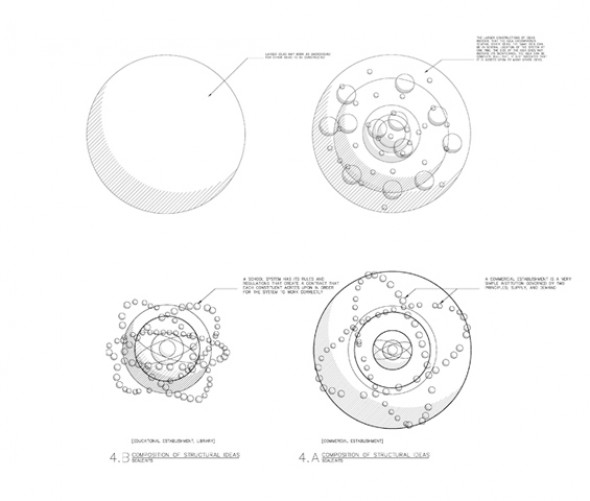
David Button: Paradigm, 2011, 2D computer drawings, architectural drawing set of 32 inkjet prints, 59,4×84,1cm // Image courtesy of David Button Studios, 2012
There’s this constant core…
DB: Yes, which is the perceptive element and I think that the perceptive element doesn’t necessarily need be a person, but something that has a certain level of consciousness that is translating information.
And it has to have some sort of autonomy?
DB: Yes, it’s definitely an autonomous entity.
Because when you’re talking about this other form that’s flexible and dynamic, it always hinges on this core that maintains some individual identity. And is each page a unique condition? You have the three overall “chapters,” but how does it work from each page to the next?
DB: Well this is a smattering of a bunch of different elements that have been pushed together, and it’s still very much in progress. However, the way that I organized this drawing (the cover page) is as a cloud of particles going through a space. I started to identify the individual elements in the spirit of a schedule, as if it were for the construction of a building. All the different elements that are on the first couple of pages are repeated throughout.
I started off with the individual, where the individual is in the front, the environment is in the back, and the reference is the space in between. The individual is, through the first pages of this set, singularly constructed, in its individual components. Then in the conversation between Dick and Jane, there is the introduction of this referential moment, where the individual is separated and can be clearly drawn in relation to another individual. I took that conversation and broke it down into its own individual parts or significant variations. This is just their particle systems relation to one another, where the previous drawings have time, space, and relationships between different things.
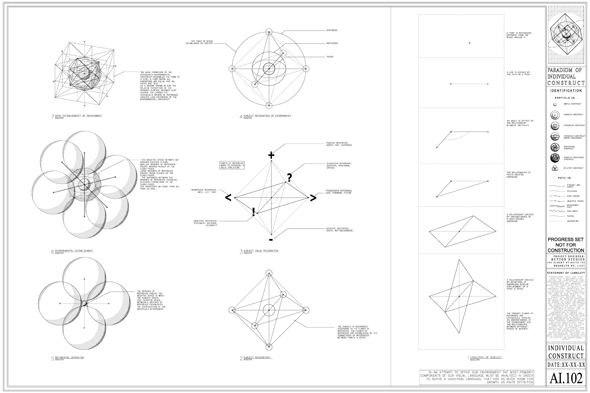
David Button: Paradigm, 2011, 2D computer drawings, architectural drawing set of 32 inkjet prints, 59,4×84,1cm // Image courtesy of David Button Studios, 2012
As we continue through, I started to focus on one individual’s particle system versus the other, and then showing the primary, secondary, tertiary, etc. realms of consciousness within the larger social construction. Then it goes through these variations, where this is the path of Jane in her life, and Dick is just on the outside of her first interactions, drawn on the periphery of her social sphere. Then I played with the notion of how an idea can exist within different frames of reference simultaneously. And individual can exist within binaries, in one case both the positive and negative sphere.
Then there is an exploration of the more direct elements of a conversation, where the individuals particle systems are in relationship to each other through this medium. Part A or B will access something in their respective consciousnesses to connect to something in the other’s consciousness in order to relate ideas. There is this dance back and forth between these subjective paths. And as these subjective paths become confirmed, agreed upon, or referenced in other exchanges, they become geometric in their interrelations. There are planarity, linearity, and fluctuating forms that develop out of these exchanges. It’s this analysis of the relationship between subjective and objective in how an idea is translated.
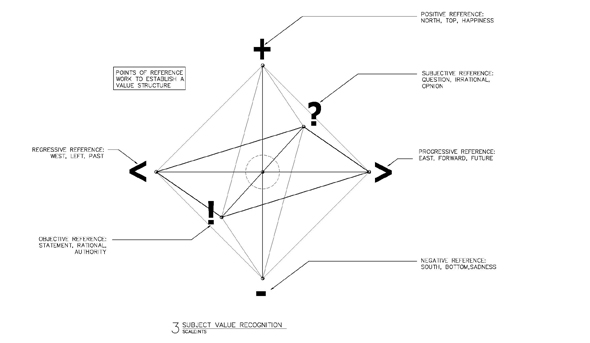
David Button: Paradigm, 2011, 2D computer drawings, architectural drawing set of 32 inkjet prints, 59,4×84,1cm // Image courtesy of David Button Studios, 2012
How long have you been working on this project?
DB: I started when I was taking a class called, “The Theory of Knowledge.” There I began thinking very seriously about what a theory of knowledge could be, and what it means. I started playing in my sketchbook, trying to explore what reality was, and I never really let go of it. It’s definitely been in my head for about 15 years now. I certainly haven’t been working on it consistently in this form (the architectural drawing set). I’ve been working on this iteration here for about two years. It’s sort of the backbone behind all my paintings and drawings, everything that I’ve been working on. To a certain extent, this is my artist statement. It’s how I see the way things work. It fits right into the architect’s set because it is a document designed to evolve.
I’m interested in how elements connect with each other. They don’t all look the same but I think that there’s an underlying scaffolding. There are certain principles of a friendship relationship, compared to a romantic relationship, an economic relationship, or an educational relationship. There are certainly these exchanges of particles, and they can happen in a limited number many ways. That ties back into this idea of a universal theory. I’ve been talking a lot with a friend of mine who is a bio-chemist. He’s working on visualizing exactly how proteins interact with mitochondria, or rather how they reproduce. It’s incredibly complicated because they have to freeze the proteins at certain points and some proteins don’t stay intact when they freeze, sometimes they collapse, or will sometimes fracture. I’m going to give him a chance to look over this drawing set, give him a red marker, and see what he thinks about these notations. Which elements are clear? Which need clarification? What needs to be added or taken away? How does a bio-chemist read these diagrams? That’s the next step, to take this into other disciplines with other modes of thinking, and really try to find universal principles. Is the way that proteins interact similar to how social structures develop and function?
People always ask me the question of scale in this project, so I just decided to do “the world” because it itself is bifurcated in this stark way: there’s a positive pole and a negative pole, an eastern and a western hemisphere. I see this as an individual’s consciousness, because we are always creating these systems of where something is or how something is, and how it is not. In many ways, that’s how we navigate our lives. That really taps into the idea of the Hungarian method: how do we construct things to achieve what we’re trying to do?
Additional Info
David Button is an artist from New York City, currently based in Berlin. He specializes in the visualization of concepts and ideas for production in art and design. In working between the disciplines of art and architecture, David Button has been building a body of work that engages conceptual questions of materiality and construction techniques in the built environment. He is currently participating in the Kulturpark project, where a group of artists and architects are developing an urban and cultural intervention for the abandoned Plänterwald amusement park this summer.
Peter Lang is a curator, art critic and editor based in Berlin. He studied theoretical physics at the Karl-Marx Universität in Leipzig in the early 1980’s, as well as cultural studies / aesthetics and drama studies at the Humboldtuniversität in Berlin from 1982 – 1988. His next show in Berlin, entitled Linie, Fläche, Zeit: Ein Abstecher will be opening at Galerie im Ratskeller Lichtenberg on July 11, 2012.
Exhibition Info
“Die Ungarische Methode” was on view at REH Kunst from February 15th until March 3rd, 2012.
REH KUNST
Opening Hours: Tuesday—Sunday, 3-7pm
Kopenhagener Straße 17, click here for map
Writer Info
Elizabeth Feder is an architect and writer from New York City currently based in Berlin. She received her BArch from The Cooper Union for the Advancement of Science and Art and recently completed her research project entitled, “Between Transience and Permanence: a New Reactivation of the Berlin Block” with the Deutscher Akademischer Austausch Dienst.


